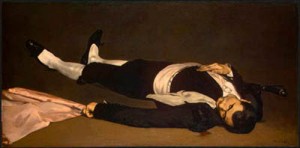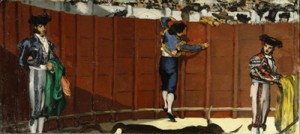Cut-Ups
John Haberin New York City
Edouard Manet: A Lost Salon Painting
John Singer Sargent: Late Landscapes
Modernism. The avant-garde, the rebels. Les independents, the loners. A world structured by the heart and the mind's eye alone. An eye instinctive as need, deliberate as the microscope, and certain as a prison warden. An eye far superior to ordinary vision or middle-class taste.
Modernism has in fact a history of refusals, but from the other side. Begin a look at new shows of Edouard Manet and John Singer Sargent with the judges.  Make that the sharpest judges of all—the cartoonists and the public.
Make that the sharpest judges of all—the cartoonists and the public.
I refuse
Establishment criticism goes back at least to the French Salon's disdain of Edouard Manet. Others as important to modern art's history as Gustave Courbet had gotten into fights before, but this one found an audience.
In 1862, Manet and other rejected artists drew crowds at their own sideshow, the Salon des Refusés. They already included Camille Pisarro. Napoleon III decreed it himself, a sign that the official juries were raising a fuss by their rejections. For this one moment, little more than the word refusal held together a new art.
Only two years later, however, Manet found himself ridiculed yet again, and this time he took it lying down. He recast his Bullfight at least once over the next dozen years before tearing it to bits. Today one knows it only from hostile reviews, burning caricatures, two fragments—and a joyous exhibition now at the Frick Collection. No wonder Edouard Manet disdained the younger outcasts' label of Impressionism, differences in style aside.
Did Modernism's idol lack the courage of refusal? Perhaps, and if that were not bad enough, step to the other side of art history's barricades.
Sometime around the turn of the century, a successful society painter decided he had had quite enough. Sargent, an American who crossed the Atlantic as lightly as money, stopped making portraits. He went off on his own, trusting to rocks, streams, light, and a lot of white paint. But surely no one would confuse Sargent with a modern or with American Impressionism? A show up in Boston tells the story.
Two small exhibitions, then, combine to reverse anyone's expectations. Or do they? The Boston show has insights to spare, but the Frick offers practically a chance to travel to the Salons in person and find out. Better still, it shares the museum not just with those great paintings by Bellini and Rembrandt, but also with some stunning northern Renaissance art. Do not miss it.
Austerity and romance
Impressionism still draws lines, of course. I guess the old refusals still pack a wallop, even today with the official juries on the side of modern museums. If there were justice in this world, then, people would be lining up for this one. From the National Gallery, the Frick has brought Manet's most shocking painting in America, Dead Toreador. And it supplies the context one needs to feel the impact all over again.
The figure's pose, just off the horizontal, insists on death. His pallor's mix of green and red manages to look horribly dead and yet still bear the traces of life. Maybe it works better now, with a century of wear to the top layer of color. Indeed, one can now just make out changes to his feet, stiffening the figure for the final composition.
The figure's diagonal also insists on grandeur, by filling the canvas that much more. His only prop, the flag he still grasps so firmly, seems to commemorate his fall. 
The Frick already owned the only other surviving fragment, figures from the rear of the arena. A slice of the bull's back just makes it in. I had always passed over this painting lightly, annoyed at its fragmentary composition. Now the intense colors and sketchy handling look free and dazzling set next to the toreador's austerity.
Manet, as everyone knows, loved Spanish themes, like his own version of Impressionism and fashion. If that seems exotic now, academic art placed its more risqué poses among the colonized and not the colonizers. To think just of bullfights, the Art Institute has a sharp sketch from the year before. For a painting of that same year, now at the Met, he posed his favorite model, Victorine Meurent, with a sword ready to attract the bull. She appears to have held her pose too long, the way one smiles for a photograph. And he had not even visited Spain yet!
He loved Spain because it promised a fresh connection to painting's past, an alternative to the Salon's decorative precision. In cutting up the bullfight, Manet preserved the two sides of Spain's inheritance. The background scene has Goya's Romantic flair, as in Goya portraits. The dead man insists on the everyday experience of life and death, the world that Edouard Manet admired of Velázquez's court servants and peasants. Not that Francisco de Goya is truly absent whenever art looks death's pallor in the face.
The theater of death
So Manet did not simply cave in. He made the original painting work, twice over—much as his Execution of Maximilian, never exhibited in the Paris of his time and then torn to fragments, exists in three versions. Or did he? In a sense, I shall never know. No trace remains of that first Salon painting, not even a final sketch.
The Frick gives Dead Toreador pride of place, as center of attention in an ample gallery. Susan Grace Galassi, the show's curator, also brings the evidence (such as it is), along with some gorgeous educated guesses. Ironically, the best clues come from the other side—some very funny newspaper cartoons of the original painting. The Salon functioned as a battleground even without the young rebels, and the French cannot resist a good fight. No wonder Manet also painted a Civil War sea battle.
The parodies stress exactly what makes the dead man so effective, stiffness. The bull has a platform with wheels, rigid and trivial as a toy. One should leave Manet, the cartoon insists, to children. These cartoons also preserve an awkward disjunction of scale between foreground and background. Similar paradoxes challenge one in Manet's greatest paintings, like the mirror in A Bar at the Folies Bergère. They make one ask where one can possibly stand, inside the scene—or apart from it.
The bull acted as a kind of hinge between the painting's two realms. Not surprisingly, then, Manet fiddled first with the animal's prominence, and he reworked the scene at least once before ditching it. Galassi deduces this focus from x-radiographs, the painting's texture, and a subtly postmodern addition to the modern art historian's repertoire, the computer. In the end, he gave up and made the painting look right. Only the bull's sliver testifies now to the original's conjunction of stiff fragments. But why?
In the previous painting, Victorine remains far out of scale with the arena. The bullfight behind her looks flat, like a painted stage backdrop. Manet lived with this, because he really accepted paint's artifice. As Michael Fried argued, he knew theater when he saw it, but more than that. He thought it about time the viewer knew it, too. One has to give up the comfortable omniscience of a traditional viewer, the perfect, detached eye of single-point perspective, in order to think in fragments.
Manet found a better painting, and he never lost his desire for acceptance. Think of it as another side of his art's wrestling with the past. Writers who stress the generation's Modernism, such as T. J. Clark, never even mention Dead Toreador. And yet Manet never fully abandoned his focus on the viewer. One passes the small painting as if out of the corner of one's eye. One has to accept death in the arena or turn away from the stark figure.
Chewing the scenery
Does the Frick asks one to deal with Manet the conservative torn to fragments? Up in Boston, the Isabella Stewart Gardner Museum goes in search of Sargent the modern.
An act of rebellion for John Singer Sargent came slowly, nearly four decades after the action now on view down in New York. (Well, Boston is like that.) Sometime around the turn of the century, he just refused to paint more society portraits. No more for him the decorative women that he might (wrongly) have found in Ingres—and that would persist with such painters as Thomas Wilmer Dewing. In fact, he turned from people altogether, started a world tour, and recorded it in landscapes.
Sargent was recapitulating the European travels of someone like Camille Corot, but he was choosing a particularly American modernity. As for Thomas Eakins and Winslow Homer, the American century meant an acid, deadpan realism. One sees Homer, too, in Sargent's beloved focus, swift-running, rocky streams. It stands at an extreme from the calm pose of a society matron.
I have never seen such lavish white paint outside of abstraction. I see Modernism, too, in the consistently high horizons or, alternatively, steeply rising cliffs. Both devices block the sky, foreseeing what Jackson Pollock fans might call an all-over painting.
Still, if the Frick makes two paintings into a glorious event, Boston frankly disappointed me. I was taken aback to find just a room, with a handful of paintings and some sketches. Still, I had a great time with the acrid white and equally intense color. One can feel these landscapes in one's bones. And I had to wonder: just how modern are they after all?
Sargent never really gives up his past, no more than James McNeill Whistler, his near contemporary. I thought of Sargent's flashy dancer just down the corridor. If his earlier sitters chewed the scenery, he does exactly that with real scenes. The bold brushwork comes straight from his portraits. No wonder skies from different countries all look alike here. John Constable or Claude Monet—or indeed Homer—would never have settled for an air of precision without also the light. Constable would have changed his mind about the sky, in fact, drawing from his huge repertoire and active imagination. Edgar Degas would have refused to add it to his collection.
Looking down on modern life
Sargent's theater derives from American landscape traditions. The falling water makes me think of Albert Bierstadt, when the late Hudson River School first went over the top. He looks back, as Homer never could.
The painter's ambivalence to his past, in fact, never really goes away. For Anita Brookner, it positively defines Romanticism. As for Monet, an acknowledgment of art's theater looks toward Modernism's bold self-awareness. Can it be only a coincidence that, down the hall, Sargent depicts a Spanish theme? The dancer may not resemble Victorine, but she would know the costume.
Perhaps even more than the late landscapes, that painting sums up Sargent's struggle with Romanticism. The artist and dancer alike go right for applause, but behind her the guitarists look down. Like the figures in the back of Manet's bullfight fragment, they are merely doing their job. Like art, it takes concentration, a concentration on the now.
Not even Manet's mirrors can sort out the paradoxes of Modernism. It does not merely substitute theater for reality. It also places the audience off its stride as Sargent never could. In the end, all it has to hold it together is that word refusal. In Modernism and Postmodernism alike, all art has for sure is a continuing struggle with its audience—and the past.

"Manet's Dead Toreador and The Bullfight: Fragments of a Lost Salon Painting Reunited" ran through August 22, 1999, at the Frick Collection. Sargent's late landscapes ran through September 26 at the Isabella Stewart Gardner Museum.




